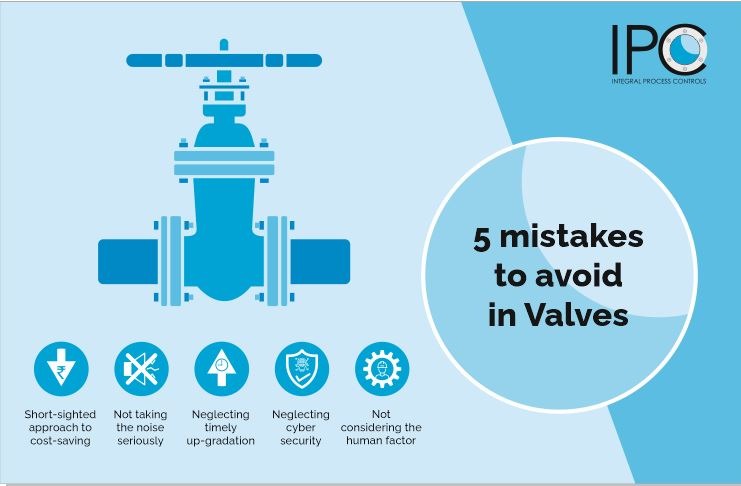The best quality valve might guard the operation against all evils, but it cannot combat one serious threat…
The threat of wrong choices and unsound operations.
For the right service, a valve must match the application it is serving. Factors such as valve material, size, or even type of seating are considered when choosing a valve. However, there exist many other considerations that might appear small, but could derail your operations if neglected.
Here are 5 mistakes to avoid when working with valves.
1. Short-sighted approach to cost-saving
When choosing a valve, the valve buying price, and the overall cost of its maintenance are the only considerations that first come to the user’s mind for cost-saving. However, cost considerations in valves do not end only at the buying price.
Low-cost valves often need more maintenance and thus incur more costs in the long run. On the other hand, many expensive valves too have a complex maintenance procedure wherein you incur more costs.
These costs add up to huge amounts in the case of big companies that have hundreds of valves.
Measures such as data-driven maintenance could reduce valve maintenance needs, reducing the related costs. Similarly, buying oversized valves increases the buying and maintenance costs. Simply sizing the valves correctly could save these added costs.
Find out more ways to reduce the total cost of ownership of valves
2. Not taking the noise seriously
In a bid to cut costs, businesses might be tempted to deploy slightly smaller valves. This is done when smaller valves can work instead of the required rightly sized valves in less critical applications. However, smaller valves are prone to noise and are vulnerable to vibrations. Vibrations can cause serious damage to pipe fittings and reduce the lifespan of valves.
Check out how vibration does serious damage to valves
Noise and vibration should thus be considered when choosing valves. Valves that are correctly sized and designed to withstand the noise and resulting vibrations should be used as per application requirements.
3. Neglecting timely up-gradation of the valves
Industrial valves are presently undergoing rapid automation. Automated valves communicate with IT systems using various communication protocols. With new communication protocols evolving, valves must adapt to match with them. Valve positioners must be able to communicate with a broad range of communication protocols from conventional analog systems to MODBUS / Foundation Fieldbus etc.
Automatic valves must be regularly upgraded to fit modern communication protocols and IT systems for efficient performance.
Explore additional factors to consider in valve automation
4. Neglecting cybersecurity of valves
As valve networks become smarter, the barriers between the physical and digital systems are disappearing. This has made physical valve networks vulnerable to cyber attacks. In 2020, India has recently been named among the countries facing the highest reported ransomware incidents in Southeast Asia.
Typically, hackers send malware or ransomware through phishing emails and take over the network. They might then demand a ransom in exchange for returning the control of smart systems. Why would international hackers target my little local business?” is not an attitude that would help in such situations. Any network can be attacked from anywhere, and hence everyone should stay protected.
Alongside measures such as firewalls, it is important to educate employees to recognize and report suspicious emails, desist from downloading dubious materials, and avoid bringing suspicious pen drives or data cards from outside into the office.
Read about the kind of damage cyber-attacks could cause to process controls
5. Not considering the human factor
Human factor engineering is the science of considering human capabilities and applying the knowledge to the design and selection of equipment, as well as processes and systems at work. The purpose of human factor engineering is to avoid errors while improving efficiency by ensuring the availability of the right tools and the right people for operations. Factors such as ergonomics and safety should be considered in designing hand-operated valves. At the same time, valve accessibility is a key factor even in automated valves.
Valves should be easily accessible to employees for maintenance or inspection. Complex piping networks sometimes mean that the employees must climb or squeeze into inaccessible places for inspection or maintenance. This increases the possibility of errors being committed. Valves should be selected, tagged, and located so that they are easy to access and repair without safety risks.
Explore how human factor engineering impacts valve operations
Conclusion
Not taking small considerations seriously could have a deep impact on valve operations. When choosing and operating valves, attention should be paid to such factors. Working closely with a long-time valve partner to address your valve issues regularly could help avoid such mistakes in the selection and operation of valves.
At IPC, we work closely with clients to design and deliver valves of the right specification and strength in the shortest possible lead time. The customers can track their valves through the design and testing processes to ensure procurement of quality valves compliant with relevant standards and application requirements.

